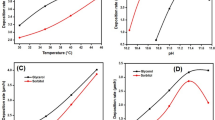Abstract
Electrodeposition of palladium from a non-aqueous electrolyte solution [choline chloride/urea/palladium(II)chloride] has been carried out by direct and pulse current electroplating. In this study, the influence of an organic additive (nicotinic acid amide), current mode (direct current or pulse current deposition) and hydrodynamic on the surface morphology of electroplated palladium films was investigated. In order to determine the surface morphology and thickness of the electrodeposited palladium layers, a scanning electron microscope and an energy dispersive X-ray fluorescence spectroscope were used. In addition, the cell voltage during the different electrodeposition experiments was recorded and analysed. The experimental results showed that the surface morphology of the palladium deposits could be remarkably affected either by addition of the additive or by applying pulse current. Pulse plating and the selected inhibitor mutually interfere with each other, causing changes in the microstructure of the palladium deposits (e.g. smoothening or forming of micro-cracks). It was possible to optimise the palladium deposit quality by applying pulse current or by addition of the appropriate inhibitor.









Similar content being viewed by others
References
Schlesinger M, Paunovic M (2000) Modern electroplating. Wiley, New York
DGO Fachausschuss Edelmetalle (1993) Galvanotechnik (Sonderdruck) 84:2
Su FY, Huang JF, Sun IW (2004) Galvanostatic deposition of palladium-gold alloys in a lewis basic EMI-Cl-BF4 ionic liquid. J Electrochem Soc 151:C811
Jou LH, Chang JK, Whang TJ, Sun IW (2010) Electrodeposition of palladium-tin alloys from 1-ethyl-3-methylimidazolium chloride-tetrafluoroborate ionic liquid for ethanol electro-oxidation. J Electrochem Soc 157:D443
Abbott AP, Capper G, Davies DL, Rasheed RK, Tampyrajah V (2003) Novel solvent properties of choline chloride/urea mixtures. Chem Commun 1:70
Bakkar A, Neubert V (2007) Electrodeposition onto magnesium in air and water stable ionic liquids: from corrosion to successful plating. Electrochem Commun 9:2428
Abbott AP, Capper G, Davies DL, Rasheed RK, Archer J, John C (2004) Electrodeposition of chromium black from ionic liquids. Trans IMF 82:14
Abbott AP, El Ttaib K, Ryder KS, Smith EL (2008) Electrodeposition of nickel using eutectic based ionic liquids. Trans IMF 86:234
Cojocaru P, Magagnin L, Gómez E, Valles E (2011) Using deep eutectic solvents to electrodeposit CoSm films ans nanowires. Mater Lett 65:3597
Böck R, Wulf SE (2009) Electrodeposition of iron films from an ionic liquid (ChCl/urea/FeCl3 deep eutectic mixtures). Trans IMF 87:28
Whitehead AH, Pölzler M, Gollas B (2010) Zinc electrodeposition from a deep eutectic system containing choline chloride and ethylene glycol. J Electrochem Soc 157:D328
Böck R, Wulf SE (2009) Elektrochemische Metallabscheidung aus tief eutektisch schmelzenden Lösungen (Raumtemperatursalzschmelzen). In: Suchentrunk R (ed) Jahrbuch der Oberflächentechnik, vol 65. Leuze, Bad Saulgau, pp 23–36
Gómez E, Cojocaru P, Magagnin L, Valles E (2011) Electrodeposition of Co, Sm and SmCo from a deep eutectic solvent. J Electroanal Chem 658:18
Lanzinger G, Böck R, Freudenberger R, Mehner T, Scharf I, Lampke T (2013) Electrodeposition of palladium films from ionic liquid (IL) and deep eutectic solutions (DES): physical-chemical characterisation of non-aqueous electrolytes and surface morphology of palladium deposits. Trans IMF 91:133
Ibl N (1980) Some theoretical aspects of pulse electrolysis. Surf Technol 10:81
Puippe JC, Leaman FH (1986) Theory and practise of pulse plating. AESF Society, Orlando
Imaz N, García-Lecina E, Suárez C, Díez JA, Rodríguez J, Molina J, García-Navas V (2009) Influence of additives and plating parameters on morphology and mechanical properties of copper coatings obtained by pulse electrodepsotion. Trans IMF 87:64
Mohan S, Ravindran V, Subramanian B, Saravanan G (2009) Electrodeposition of zinc-nickel alloy by pulse plating using non-cyanide bath. Trans IMF 87:85
Böck R (2008) Stand der Aluminiumabscheidung aus halo-aluminathaltigen ionischen Flüssigkeiten. In: Suchentrunk R (ed) Jahrbuch der Oberflächentechnik, vol 64. Leuze, Bad Saulgau, pp 21–33
Tang J, Azumi K (2011) Optimization of pulsed electrodeposition of aluminium from AlCl3-1-ethyl-3-methylimidazolium chloride ionic liquid. Electrochim Acta 56:1130
Li B, Fan C, Chen Y, Lou J, Yan L (2011) Pulse current deposition of Al from an AlCl3-EMIC ionic liquid. Electrochim Acta 56:5478
Ispas A, Bund A (2012) Pulse plating of tantalum from 1-butyl-1-methylpyrrolidinium bis (trifluoromethylsulfonyl)amide ionic liquids. Trans IMF 90:298
Hedrich HD, Raub ChJ (1979) Der Einfluss von Inhibitoren auf die Palladiumabscheidung im Palladiumtetramminchloridelektrolyten. Metalloberfläche 33:308
Hedrich HD, Raub ChJ (1977) Untersuchungen zur galvanischen Palladiumabscheidung. Metalloberfläche 31:512
Raub ChJ (1974) Probleme der Inhibitoren in der Galvanotechnik. Werkst Korros 25:720
Acknowledgments
The authors would like to thank Deutsche Forschungsgemeinschaft (DFG) for financial support (project no. ZI 596/4-1 and LA 1274/20-1).
Author information
Authors and Affiliations
Corresponding authors
Rights and permissions
About this article
Cite this article
Böck, R., Lanzinger, G., Freudenberger, R. et al. Effect of additive and current mode on surface morphology of palladium films from a non-aqueous deep eutectic solution (DES). J Appl Electrochem 43, 1207–1216 (2013). https://doi.org/10.1007/s10800-013-0608-4
Received:
Accepted:
Published:
Issue Date:
DOI: https://doi.org/10.1007/s10800-013-0608-4




